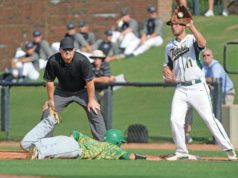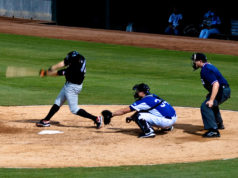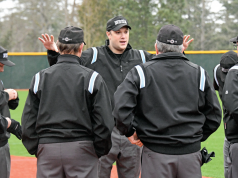When a ball becomes dead, such as one thrown into the stands, it is usually obvious. There are instances though where an act occurs during a play which will cause the ball to become dead after playing action ceases. In football, a flag is thrown for a foul and the ball becomes dead to assess a penalty. In baseball, the umpires don’t have flags and there is no indication from the officials that they will declare the ball dead when the play ends except for the call of “That’s obstruction” when it occurs. NFHS and NCAA use “delayed dead ball” to describe the “penalty” situations. That term does not appear in the Official Baseball Rules, but nonetheless those situations are there. There are roughly 10 different delayed dead ball scenarios and almost twice that number for cases when the ball becomes immediately dead. Here are some examples.
Obstruction.
Obstruction may result in either an immediate dead ball or a delayed dead ball. In NFHS, play is always allowed to continue until playing action ends. However in NCAA and pro play, if the obstructed runner is being played on, the ball is immediately dead and the play is stopped (NCAA 2-55 Type I; pro 6.01h1). If a runner who is not being played on is obstructed, the play is allowed to proceed and the obstruction is addressed after all play action ceases (NFHS 5-1-2b; NCAA 2-55 Type II; pro 6.01h2).
Situations where obstruction may occur while the runner is not being played on include the batter-runner rounding first on a base hit while the ball is in the outfield and runners rounding second or third on a hit to the outfield.
If a play is subsequently made on the obstructed runner (after an umpire allows play to continue) and such play results in the runner being tagged out before reaching the base he would have been awarded, the umpire does not call time until all other playing action has ceased. He then makes the obstruction award.
When obstruction occurs and play is allowed to continue, the runner must continue to “do what he is supposed to do.” If he does not, or if an obstructed runner subsequently commits a baserunning infraction (most likely a missed base), the umpire should be guided by the closeness of the play at the plate and the amount of delay caused by the obstruction.
If the runner advances beyond the base he would have been awarded, he does so at his own risk. If he is subsequently tagged out, the umpire must determine whether the obstruction had any bearing on the out. If not, the out shall stand despite the obstruction.
Balks.
A balk is an illegal act by the pitcher with a runner or runners on base and entitles all runners to advance one base. In a high school game, the ball is dead without exception when a balk occurs and any play that may follow doesn’t count. When a balk is called in NCAA and pro play, the ball remains live until playing action has ended and runners may advance beyond the base to which they are entitled at their own risk (NCAA 9-3 Pen. 1 Nt. 1; pro 6.02 AR 1). If the pitcher stops when the balk is called, retaining possession of the ball, the ball is immediately dead and all runners are awarded one base. Any count on the batter remains the same, thus the batter can never be awarded first.
Pitch follows balk.
If the pitch is batted and all runners (including the batter-runner) advance, the balk is ignored and the play stands. If the pitch is batted and all runners (including the batter-runner) do not advance, the pitch is canceled and the balk is enforced. There are no options for either team. The results of the play determine whether the balk is enforced or ignored (NCAA 9-3 Pen.; pro 6.02 Pen.).
If the pitcher continues and delivers to the batter, who either swings and misses or doesn’t swing and the pitch is caught by the catcher with no advance, the balk is enforced.
If the pitch is not caught by the catcher and is ball four or strike three and all runners advance (including the batter-runner), the balk is ignored and play proceeds without reference to the balk; the result of the play stands. If the pitch is not caught by the catcher and only the runners advance (not the batter), the balk is acknowledged, the pitch is canceled and any play on the runners beyond the awarded base stands (NCAA 9-3 Pen. 3; pro PBUC 8.9-5).
Throw follows balk.
If the pitcher continues and throws to a base and the ball is caught, the ball is dead and any out is voided. If the ball is overthrown and all runners advance at least one base, the balk is ignored. Runners may advance beyond the base to which they are entitled at their own risk. If all runners do not advance one base, the balk penalty is enforced; otherwise the balk is ignored (NCAA 9-3 Pen. 2; pro PBUC 8.9-7).
A runner who misses the first base to which he is advancing and who, prior to the next pitch, is later called out on appeal, is considered as having advanced one base for the purpose of the balk rule (NCAA 9-3 Pen. 1 Nt; pro 6.02 AR 2).
Interference.
Almost all acts of interference result in an immediate dead ball. That makes perfect sense because the act of interference almost always alters the play significantly enough that it would be unfair to continue play. Umpires must be familiar with each type of interference and understand whether or not to keep the ball live.
Unfortunately there is no simple way to categorize the different types of interference by when the ball becomes dead. For example, if a non-player such as a coach interferes, the ball is delayed dead, but if the non-player is a spectator, the ball is immediately dead. Umpires are also non-players and when they get involved, we have the full gamut of outcomes. If an umpire interferes with a catcher’s throw, the ball is delayed dead. If an umpire interferes with a batted ball, the ball is dead if a fair ball touches an umpire in fair territory before touching an infielder, including the pitcher, or passing an infielder other than the pitcher. However if a fair ball touches an umpire after having passed an infielder other than the pitcher, or after having touched an infielder, including the pitcher, the ball remains live and in play. If a pitch or thrown ball touches an umpire, the contact is ignored and the ball also remains live. The same is true if a runner or fielder collides with an umpire.
If the catcher interferes with the batter it’s a delayed dead ball if the interference is with the batter’s swing; otherwise the ball is immediately dead. If the batter’s swing interferes with the catcher’s throw, the dead ball is delayed; if the swing interferes with the catcher’s fielding or a play at the plate, the ball is immediately dead
What's Your Call? Leave a Comment:
Note: This article is archival in nature. Rules, interpretations, mechanics, philosophies and other information may or may not be correct for the current year.
This article is the copyright of ©Referee Enterprises, Inc., and may not be republished in whole or in part online, in print or in any capacity without expressed written permission from Referee. The article is made available for educational use by individuals.

















